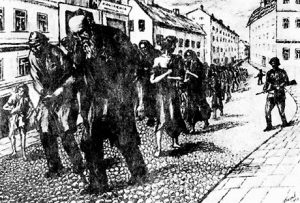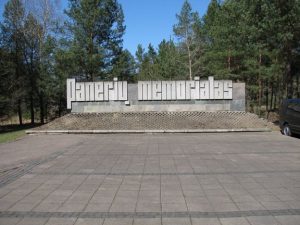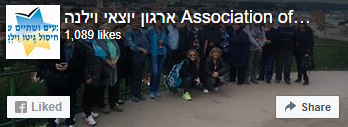Ponar
 Ponary is a bucolic forest about 10 kms south of Vilna which the Nazis turned into a valley of death for the Jews of Vilna and its surroundings. Today, they estimate that there were about 80,000 victims in Ponary, of which 80% were Jews and the remainder Soviet prisoners and civilians from Poland, Russia, Lithuania and other countries, who were suspected of hostile activity towards the Nazi regime.
Ponary is a bucolic forest about 10 kms south of Vilna which the Nazis turned into a valley of death for the Jews of Vilna and its surroundings. Today, they estimate that there were about 80,000 victims in Ponary, of which 80% were Jews and the remainder Soviet prisoners and civilians from Poland, Russia, Lithuania and other countries, who were suspected of hostile activity towards the Nazi regime.
Before the war the Soviets prepared large, round pits for fuel storage that would be hidden and safe from the bombing. The pits were not all the same size: their diameters varied from 15 to 50 meters and they were from 3 to 8 meters deep. They were surrounded by sand mounds from the sand that had been dug up. A railway line ran through the forest. These pits became mass graves.
The Jews were brought to Ponary directly after the Aktions or from the Lukishki prison, which served as a "sorting center". In many instances, the rate of the capture of the Jews was faster than the extermination rate at Ponar, so the prison also served as a temporary camp. The conditions there were insufferable. The inmates lived in extremely cramped conditions; they were filthy, hungry and thirsty, tortured by the Germans and the Lithuanians. Sometimes they had to wait there for days and even weeks.
The EinzatKommando 9 (E"K), together with the Lithuanians, started the mass extermination program. It was carried out by 3 different forces. The first force dealt with the transfer of Jews from city to city. Trucks were used to transfer the Jews from Lukishki prison whereas those who were snatched from their homes and from the streets were taken by truck or had to march on foot. Most of the force was Lithuanians. The second force was a security force, most of whom were Germans. This force ensured that the area was completely closed off, even to the officers of the Wermacht, as well as making sure that none of the prisoners escaped. The third force was the shooting unit under the leadership of Oberschtumfirer Schauschutz from E"K 9. Most of them were Lithuanians and they were the ones who exterminated the victims in the pits.
The Jews who were brought to Ponary and assembled in a waiting area where they had to undress completely and hand over any things of value that they had. After they were registered, they were blindfolded or their faces were covered and they were led to the pit, made to stand behind one another in groups of 10 to 20, holding hands. The line was led by a Lithuanian. When they reached the pit, the Jews were spread out along the mounds of sand that surrounded the pit and they were shot. The victims would fall into the pit, including those who were injured. They would then be covered with a thin layer of sand and if the Lithuanians saw any movement, they would shoot again from above. Then a second group would come and so on. This way it was possible to kill up to 500 people a day.
The system of killing at Ponary was described in the diary of Kazimierz Sakowicz, an eye witness, in the following manner: "The Jews were brought to a central meeting point (a neighborhood). They were commanded to lie face down. After that, every so often, a few dozen would be taken close to the pit. Here they hit the Jews, tortured them and ordered them to undress (after which a number of different methods of extermination were employed): (1) The Jews were placed on a trampoline over the pit and when those sentenced to death stood on it, they were shot dead. (2) A few dozen Jews were led to the edge of the pit and they were shot there. (3) Jews were tossed into the pit and a grenade was thrown into the pit. (4) TheJews were led in lines into trenches, fully dressed. In the trenches, the Jews were told to undress. Then they were shot with a machine gun. Jews sat on the road, not knowing that they would shortly be murdered."
In July, 1944, 5,000 Jews, almost all of whom were males, were exterminated in Vilna by the EK9. The tragic significance of this was that five thousand families were left, fatherless and husbandless, and without a breadwinner (on the assumption that an average family comprised four members).When the Jews of Vilna were forced into ghetto two months later, the lives of those families would be doubly hard and the burden of existence would fall on the mother's shoulders.
News about what was happening at Ponary leaked out gradually and was greeted with total disbelief. Diary writers mention it in the latter half of July, but they refer to it as a work place. On the 20th of July, Herman Kruk mentions that there were rumors about shootings at Ponary, but they were dismissed as false rumors. There were also those who dismissed the stories of residents in the area about the constant shooting in the forest, saying they were Anti-Semites, who wanted to break the spirit of the Jews. The Judenrat refused to believe the rumors. Over a period of time, chilling stories of women and children who had not been shot and returned to the city, came to light. Kruk and Korczak tell of a meeting with Yehudit Troyak, an 11-year old girl from 11 Shavilli Street, who was taken to Ponary on the 2nd of September, 1941 (at the time of the great provocation). The girl was rescued from the pit (along with five other women), since she was only injured during the shooting and was treated by one of the other women. The meeting took place at the hospital on Szpitalna Street, where she gave a detailed description of the extermination process.
Kruk also recounted the story of 16-year Pessa Schloss, who was rescued from the pit at Ponary: fortunately for her, the bullet that was aimed at her hit her mother who was alongside her. Korczak brings the stories of two other survivors, Tima Katz, a teacher, and Kagan who were brought to Ponary at the beginning of December. Dvoretski tells of his meeting with Pessiah Aharonowitz, a mother of two, who was also rescued at Ponary at the same time. After he heard what had happened to her: the detention at the Lukishki prison, her removal to Ponary, the assembly at the waiting area, the walk to the pit, the shots and the feeling that she was alive, surrounded by dead bodies, the rescue from the pit and the return to the city – "could you believe it or not? Is this the truth or the delusions of a sick mind? These were the thoughts that raced in my mind." Even after the ghettoes were established, the rumors abounded that Ponary was the third ghetto and that the municipality of Vilna sent bread there every day. Balberishski relates that he heard the story froma survivor of Ponary who lay injured in the ghetto hospital. She gave a very detailed description of the way they shot a large group of Jews but the bullet only injured her and how she managed to reach the ghetto; some of the doctors who were standing around her bed pointed to her head to indicate that she was insane. It took some time until the undeniable truth about Ponary and its significance were disseminated.
Ponary was an extermination center for the entire period of the Nazi regime in Vilna. Even after the ghetto was liquidated, Jews who were found in hiding and those who had been sent to work camps were sent there. In addition to those, Jews were brought from Kovno, Germany and Czechoslovakia, as well as non-Jews, to be exterminated in Ponary.
In 1943 the Germans began erasing the traces of the extermination program at Ponary. This was done within the framework of a secret plan entitled "1005 Campaign". It was designed to cover up the signs of murder and to erase all testimony to the terrible crimes that were committed in the death camps and the sites of the mass murders. The Gestapo put together a team of seventy Jews, nine Soviet prisoners and one Pole (who had been arrested because he hid a Jewish girl) under Weiss to carry out the job. They were housed at Ponary in a large pit, 15 meters diameter and 8 meters deep. During the day they burnt the bodies. At night they would climb down to the bottom of the pit where their legs were bound with a short rope, so that they could only take one step.
The group was divided into work teams: pit diggers who opened the mass graves and removed the bodies; porters who carried the bodies to the incinerators; the body burners who piled up logs, pyramid-style, ("pyres") into which they put the bodies according to a special system; the wood suppliers who cut the wood in the forest and brought it in; the bone grinders who gathered the bones that had not burnt, crushed them to ashes inside a crater; the ash sifters who would sift the ash and add any bones that were found and crush them again; finally, those who covered the traces by mixing the ash with the earth and pouring it back into the pits. At one pyre they would burn 3,500 bodies and the conflagration would burn for 7 to 10 days. They used wicks soaked in oil and fuel to kindle the fire. Under German orders, they were forbidden to use the words "corpse" or "dead body" and they had to use the words "image" or "object". There were instances when the body burners identified members of their families among the victims. One of the survivors, Yitzhak Dugin, recounts: "When I put the dead on the pyre I identified my family: my mother, my wife, three sisters and two nephews. I recognized my wife by her necklace which I had given her on our wedding day. After my wife had been burnt I removed the necklace. The two small pictures of the two of us had already been engulfed by the fire."
The body burners knew what fate awaited them and they searched for a means of escape. They were kept under heavy surveillance, so they decided to escape through an underground tunnel from the pit in which they lived to beyond the fence of the site, about 35 meters. They dug the tunnel at night, using a spoon and a shovel. They spread the sand evenly so that it would not be noticed from the outside. Yitzhak Dugin and Shlomo Gol headed the task. It took about three months. On the night of the 15th April, 1944 the escape began. The prisoners cut through the rings of the cables with a file and in rows of tens, quickly made their way from the tunnel. Unfortunately, they were discovered by the German guards and most of them were killed during the escape. Nevertheless, fifteen managed to escape, including Dugin, Gol and Mordechai Zeidel, and they joined up with the partisans in the Rudninki Forest.
Written by Dr. Aharon Einat based on his doctoral dissertation, "Daily Life in the Ghetto of Vilna" to the Hebrew University, 2006
For further reading: Panerai under the Soviets: Between Abandonment and Commemoration


